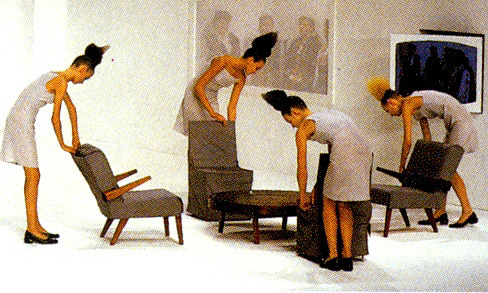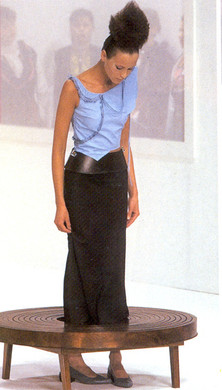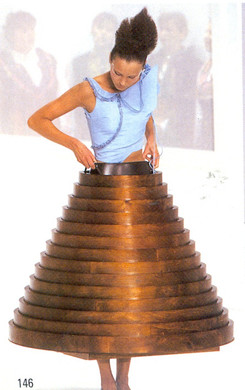One of the most beautiful shows of the past 30 years
- kikokurative

- Sep 25
- 4 min read
After Words, Fall Winter 2000 by Hussein Chalayan.
Hussein Chalayan is in my opinion, a name far too rarely mentioned when discussing the history of fashion and the iconic runway shows that have left a lasting impact.
Today, I want to focus on After Words, Hussein Chalayan’s Fall-Winter 2000 collection, which I consider one of the most influential shows of the past 30 years.

To fully appreciate this groundbreaking show, it’s important to understand Hussein’s background.
Born in 1970 in Nicosia, Cyprus, Hussein belongs to the island’s Turkish minority.
Cyprus gained independence in 1960, but tensions between the majority Greek Cypriots and the Turkish minority soon escalated. In 1963, violent clashes erupted, leading to a division of communities and ongoing conflict that lasted until 1974.
These early experiences of violence and displacement deeply influenced Hussein’s creative vision, a theme that runs strongly through his work especially in After Words.
Hussein : "I remember asking my mother, like what would be the first thing you would want to take with you when you know that your neighborhood will be raided ? And she said to me : it will be my old photographs, it would be a blanket and maybe my favorite clothes. And then that was something that stayed with me, but I wanted to turn this kind of, let’s say horrific situation into a performance."
The show opens with a family sitting together. Hussein simply wanted them to be there, a quiet reminder that displacement can happen to any family, at any time. This same family eventually gets dressed and leaves. They flee.
The show takes place in a room decorated with 1960s-style furniture. At first, the audience assumed it was just part of the set design, aesthetic, symbolic perhaps but in reality, the models were about to interact directly with these objects.

In the background, haunting Bulgarian folk chants echo throughout the space, adding a dramatic, almost ritualistic atmosphere to the performance.
At first glance, the dresses might appear deceptively simple. But a closer look reveals complex constructions, full of precise pleating almost like origami.
The makeup was created by the legendary Pat McGrath, whose signature touch added another layer of storytelling to the collection. Some of the garments also featured integrated gloves, not just accessories, but actual pockets built into the clothing itself.
The central concept behind the collection was displacement. Three black dresses appear midway through the show, a visual metaphor for ominous signs, like three black birds heralding bad news, foretelling the moment of exodus.
In the final scene, four models approach the chairs. Slowly, they begin unzipping and flipping over the seat covers. What seemed like ordinary upholstery is revealed to be meticulously tailored these covers are, in fact, dresses, perfectly designed to fit the geometric contours of the chairs.

Hussein : "It was quite technical, of course the cloths that were hidden as chair covers, that was a very long process of trial and error, because whatever fits the body wouldn’t fit the chair automatically. So you have to go back and forth until it was right. I remember it being quite challenging, but also very satisfying"
In the span of just 30 seconds, the entire living room was transformed into something that could be taken along. Four chair covers came to life as four elegant dresses, some people even broke into spontaneous applause.
It was still a time when the audience sat with notebooks and pens, fully focused. There were no iPhones. That moment could have easily served as the perfect finale.
But then, model Natalia Semanova entered. She was wearing an asymmetric bodice and slowly lifted a circular panel at the center of the coffee table.
She cautiously stepped into the table, the opening was just wide enough to let her in. Gripping two hidden handles, she pulled. The coffee table began to unfold, piece by piece, gradually transforming into a stunning, sculptural A-line dress.
Hussein : "I think the biggest trick here was the weight. The model had to be able to lift it up, and she had to be able to walk with it. And the other trick was that the legs had to flip up, they were spring-loaded, so the model could pick it up and fold it back in. I really thought so many things would go wrong during the show because the model might not get the process right, but luckily, everything went as planned."

No one was expecting it, it was breathtaking. It wasn’t just a runway show, it was a true performance. And that’s something the fashion world would come to appreciate even more in the years to follow.
Knowing Hussein’s story and the message he sought to express in this show, the runway becomes much more than just a presentation, it transforms into a poignant narrative.
The spectacle of furniture seamlessly turning into garments evokes the powerful theme of fleeing one’s home, a graceful embodiment of exile and departure through the language of fashion.




































Comments